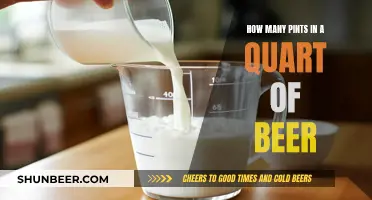
Alcohol units were introduced in the UK in 1987 to help people keep track of their drinking. One unit equals 10ml or 8g of pure alcohol, which is roughly the amount processed by the body in an hour. The number of units in a drink depends on its size and alcohol strength. For example, a pint of 5% lager contains nearly 3 units, while a pint of lower-strength lager has just over 2 units. So, 3 pints of beer could contain anywhere from 4 to 9 units of alcohol, depending on the strength of the beer.
| Characteristics | Values |
|---|---|
| Number of pints | 3 |
| Volume per pint (ml) | 568 |
| ABV per pint | 5% |
| Number of units per pint | 2.3-2.95 |
| Total number of units | 6.9-8.85 |
What You'll Learn
- A unit of alcohol is a measure of the amount of pure alcohol in a drink
- One unit equals 10ml or 8g of pure alcohol
- Alcohol by volume (ABV) is a standard measure of the amount of alcohol in a drink
- ABV is expressed as a volume percentage, showing what portion of the total volume is alcohol
- Beers typically contain 2% to 8% alcohol

A unit of alcohol is a measure of the amount of pure alcohol in a drink
The number of units in a drink is based on the size of the drink and its alcohol strength. For example, a pint of strong lager contains almost three units of alcohol, while the same volume of lower-strength lager has just over two units. A half-pint of average-strength (4%) lager is equivalent to one unit of alcohol.
The concept of counting alcohol units was introduced in the UK in 1987 to help people monitor their drinking. Units provide a simple way to calculate the quantity of pure alcohol in a drink. This can be calculated using the following formula:
Strength (alcohol by volume or ABV) x volume of the drink (in millilitres) ÷ 1,000 = total number of units in the drink
For instance, a pint of 4% ABV beer contains 2.3 units of alcohol:
4 (ABV%) x 568 (ml) ÷ 1,000 = 2.3 units
Men and women in the UK are advised not to regularly drink more than 14 units of alcohol per week. This is equivalent to six pints of average-strength beer or ten small glasses of lower-strength wine. It's important to note that there are no safe levels of alcohol consumption, and the low-risk guidelines are based on average risk.
Fireball Pint Mystery: How Many Beers?
You may want to see also

One unit equals 10ml or 8g of pure alcohol
In the UK, a unit of alcohol is a measure of alcohol consumption representing a fixed amount of pure alcohol. The idea of counting alcohol units was introduced in 1987 to help people keep track of their drinking. One unit contains 10ml or 8g of pure alcohol, which is roughly the amount of alcohol the average adult can process in an hour. This will vary from person to person, depending on body weight, sex, age, metabolic rate, recent food intake, and other factors.
The number of units in a drink is based on its size and alcohol strength. For example, a pint of strong lager contains 3 units of alcohol, while the same volume of lower-strength lager has just over 2 units. A pint of 4% ABV beer contains 2.3 units, calculated as follows:
Strength (ABV%) x volume (ml) ÷ 1,000 = units
4 (ABV%) x 568 (ml) ÷ 1,000 = 2.3 units
Using units is a simple way to represent a drink's alcohol content, which is usually expressed as alcohol by volume (ABV). ABV is the measure of the amount of pure alcohol as a percentage of the total volume of liquid in a drink. You can find the ABV on the labels of cans and bottles or by asking bar staff. For instance, a drink labelled "12% ABV" means 12% of the volume of that drink is pure alcohol.
You can calculate the number of units in any drink by multiplying the total volume of the drink (in ml) by its ABV (measured as a percentage) and then dividing the result by 1,000.
It's important to note that there is no international consensus on how much pure alcohol is contained in a standard drink, and the definition varies from country to country. In the UK, both the volume and ABV of a drink are usually mentioned on the bottle, making it easy to calculate the number of units.
Beer Consumption: Daily Pint Limits for Beer Enthusiasts
You may want to see also

Alcohol by volume (ABV) is a standard measure of the amount of alcohol in a drink
For example, if a drink has an ABV of 40%, it means that 40% of the total volume of that drink is pure alcohol. So, if you have 100ml of that drink, 40ml of it is pure alcohol.
The ABV of a drink is important to understand to stay in control of your drinking. It can be difficult to determine, but it is a useful concept to grasp as it helps you keep track of your alcohol consumption. This is especially important because alcohol is processed differently by the body compared to other foods and liquids. It passes through the stomach and enters the bloodstream through the walls of the small intestine. The liver then metabolises the alcohol, but only at a certain rate, which is why it is important to keep track of how much alcohol you are consuming.
You can calculate the number of units in a drink by multiplying the total volume of the drink (in ml) by its ABV (as a percentage) and then dividing the result by 1000. So, for example, a pint of beer (568ml) with an ABV of 4% would contain approximately 2.3 units of alcohol.
To keep health risks from alcohol low, men and women are advised not to drink more than 14 units a week on a regular basis.
Explore Beer's Diverse World: Styles and Classifications Unveiled
You may want to see also

ABV is expressed as a volume percentage, showing what portion of the total volume is alcohol
A pint of 4% ABV beer contains 2.3 units of alcohol. Therefore, 3 pints of 4% ABV beer contain 6.9 units of alcohol.
ABV stands for Alcohol By Volume. It is a standard measurement used worldwide to assess the strength of a particular beer. The ABV scale is simple: the higher the ABV, the more alcohol that beer contains. ABV is expressed as a volume percentage, showing what portion of the total volume is alcohol. For example, a 12-ounce bottle of beer that is 5% ABV means that the bottle has 0.6 ounces of pure alcohol. This is because 12 x 0.05 = 0.6.
The ABV of a beer is calculated by comparing the amount of sugar present in the beer at the start of fermentation to the amount of sugar remaining at the end of fermentation. Higher ABV beers are achieved by using higher amounts of fermentable sugars in their recipe. Brewers can also use a method called forced fermentation to learn the approximate ABV of the beer before the full batch has completed its fermentation.
How an Extra Pint of Beer Affects Your Body
You may want to see also

Beers typically contain 2% to 8% alcohol
Three pints of beer will contain 6 to 8 units of alcohol, depending on the strength of the beer. Beer typically contains between 2% and 8% alcohol, with an average ABV (alcohol by volume) of 5%. This means that a pint of beer will contain between 2 and 3 units of alcohol. Therefore, three pints of beer will contain between 6 and 8 units.
The ABV of beer varies depending on the style, brand, and brewing methods. Light beers tend to have a lower ABV, typically ranging from 3.5% to 4.5%. Wheat beers usually have an ABV between 4% and 5.5%, while pale ales have a slightly higher alcohol content, typically ranging from 4.5% to 6%. India Pale Ales (IPAs) have a higher ABV, usually between 5.5% and 7.5%. Stouts can vary significantly in their alcohol content, ranging from 4% to 10% ABV. Belgian-style ales are known for their high ABV, typically ranging from 5% to 12%.
It's important to note that the number of units in a drink is based on both the size of the drink and its alcohol strength. Units are a way of expressing the quantity of pure alcohol in a drink, with one unit equal to 10ml or 8g of pure alcohol. This is the amount of alcohol that the average adult can process in an hour. By knowing the number of units in a drink, individuals can better understand their alcohol consumption and make informed choices about their drinking.
Barrel of Beer, Pints Galore: How Many?
You may want to see also
Frequently asked questions
This depends on the ABV (alcohol by volume) of the beer. A pint of 4% ABV beer contains 2.3 units, so 3 pints would contain 6.9 units. A pint of 5% ABV beer contains 2.8 units, so 3 pints would contain 8.4 units.
You can calculate the number of units in a drink by multiplying the total volume of the drink (in ml) by its ABV (measured as a percentage) and dividing the result by 1,000.
The UK government recommends that men and women should not drink more than 14 units of alcohol per week on a regular basis.







